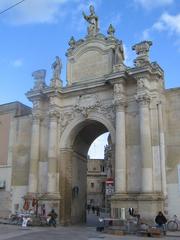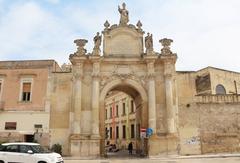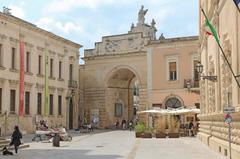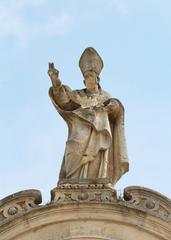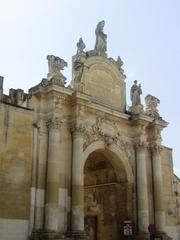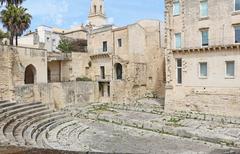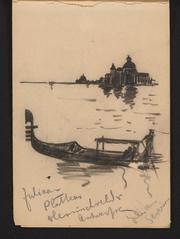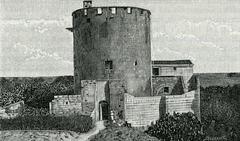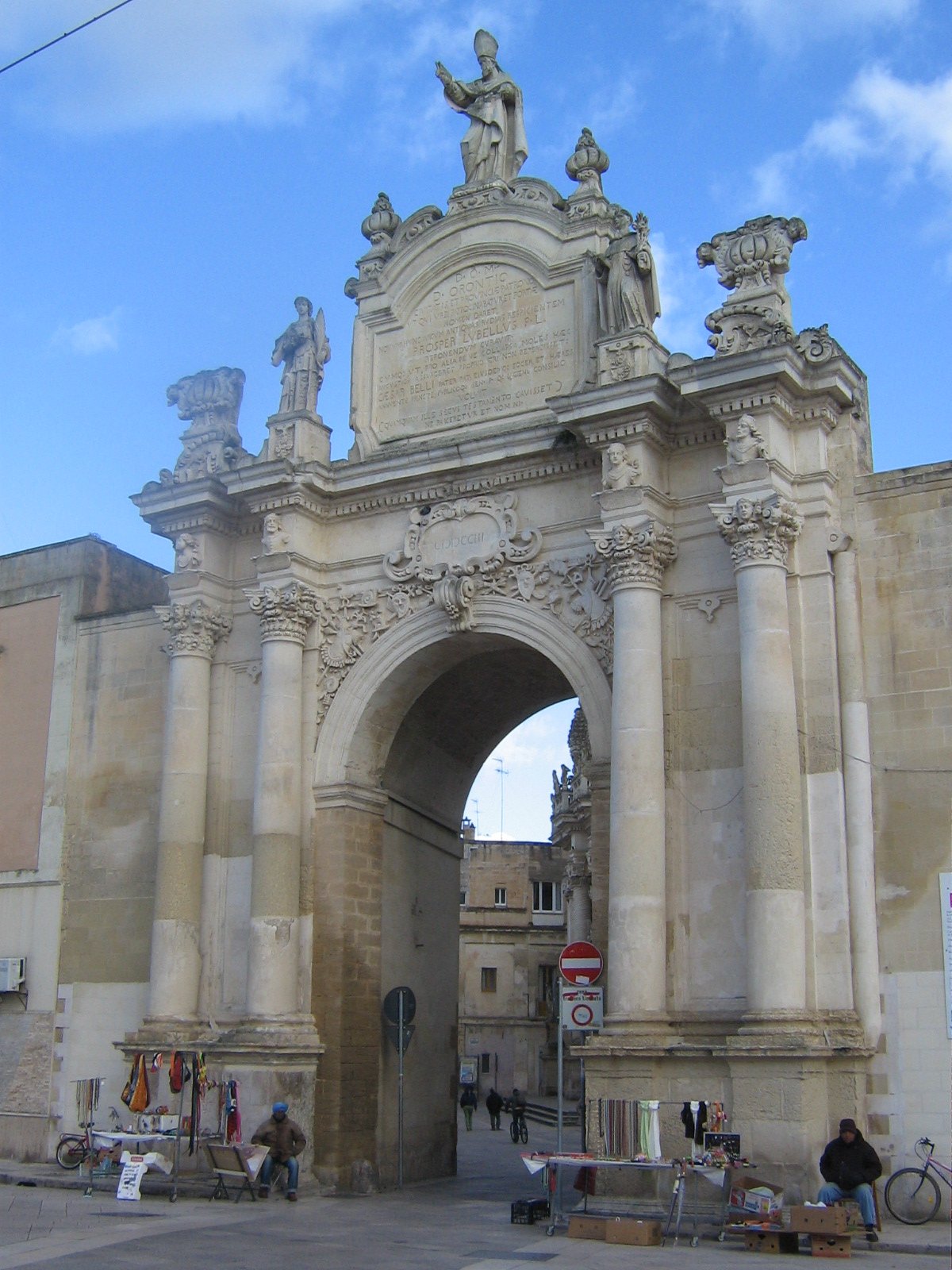
Porta Rudiae Visiting Hours, Tickets, and Historical Sites in Lecce
Date: 18/07/2024
Introduction
Porta Rudiae stands as a monumental gateway into the historical and architectural splendor of Lecce, Italy. Known as one of the three remaining gates from the city’s original twelve, Porta Rudiae offers a profound glimpse into Lecce’s rich past, dating back to the Roman era. The gate has witnessed centuries of transformations—from its origins in the 1st century BC as part of the Roman municipium of Lupiae, through periods of Byzantine, Lombard, and Norman rule, to its significant reconstruction under the reign of Charles V in the 16th century. Porta Rudiae’s architectural grandeur, adorned with classical and Baroque elements, symbolizes the city’s enduring resilience and cultural heritage. This comprehensive guide will explore the historical significance, architectural features, visitor information, and travel tips for Porta Rudiae, providing an enriching experience for history enthusiasts, architecture aficionados, and curious travelers alike. For more detailed information on visiting hours, tickets, and nearby attractions, keep reading.
Table of Contents
- Introduction
- Roman Origins and Medieval Transformations
- The Triumphal Arch of Charles V
- Symbolism and Architectural Significance
- Visitor Information
- Travel Tips and Nearby Attractions
- Special Events and Guided Tours
- Photographic Spots
- Porta Rudiae Today: A Gateway to the Past and Present
- FAQs
- Conclusion
Roman Origins and Medieval Transformations
The origins of Porta Rudiae can be traced back to the Roman era, likely dating back to the 1st century BC. During this period, Lecce, known as Lupiae, flourished as a Roman municipium. The gate served as a crucial access point to the city, forming part of the defensive walls that encircled it.
Following the fall of the Roman Empire, Lecce, like many Italian cities, witnessed periods of instability and changing rulers. During the medieval period, the city came under Byzantine and Lombard rule and later became part of the Norman Kingdom of Sicily. Throughout these transitions, Porta Rudiae remained a vital part of the city’s defenses, undergoing modifications and reinforcements to adapt to evolving military strategies.
The Triumphal Arch of Charles V
The most significant transformation of Porta Rudiae occurred in the 16th century under the reign of Charles V, the Holy Roman Emperor and King of Spain. In 1548, Charles V commissioned the construction of a grand triumphal arch to replace the existing medieval gate. This decision was driven by a desire to fortify the Kingdom of Naples, which included Lecce, against the threat of Ottoman incursions.
The design and construction of the arch were entrusted to Gabriele Riccardi, a renowned architect from Lecce. Riccardi drew inspiration from Roman triumphal arches, incorporating elements of classical architecture such as Corinthian columns, a prominent entablature, and intricate sculptural decorations. The arch was completed in 1549 and dedicated to Charles V, serving as a symbol of his power and the city’s gratitude for his protection.
Symbolism and Architectural Significance
Porta Rudiae stands as a testament to the enduring legacy of Roman influence on Italian architecture. The arch’s design, with its classical elements and imposing scale, evokes the grandeur of ancient Rome and serves as a reminder of Lecce’s Roman past.
Beyond its historical significance, Porta Rudiae is also notable for its intricate sculptural decorations. The arch is adorned with various figures and symbols, each carrying symbolic meaning. At the top of the arch, a statue of Sant’Oronzo, the patron saint of Lecce, stands prominently, holding the city in his hand. Other sculptures depict mythological figures, allegorical representations of virtues, and scenes from Roman history. These decorations not only enhance the arch’s aesthetic appeal but also offer insights into the cultural and religious beliefs of the time.
Visitor Information
Visiting Hours
Porta Rudiae is accessible to visitors 24/7, though the best time to visit is during daylight hours to fully appreciate its architectural details.
Tickets
There is no admission fee to view Porta Rudiae, making it an accessible landmark for all visitors.
Travel Tips and Nearby Attractions
Travel Tips
- Wear Comfortable Shoes: The historic center’s cobblestone streets can be challenging to navigate.
- Bring a Camera: Capture the intricate details of the arch and surrounding sites.
- Stay Hydrated: Carry a reusable water bottle, especially during the hot summer months.
Nearby Attractions
After exploring Porta Rudiae, consider visiting other historical sites in Lecce, such as:
- Roman Amphitheatre
- Basilica di Santa Croce
- Piazza del Duomo
These sites are within walking distance and offer a deeper dive into Lecce’s rich history.
Special Events and Guided Tours
Photographic Spots
For photography enthusiasts, Porta Rudiae offers numerous angles for capturing its grandeur. The best time for photos is early morning or late afternoon when the lighting enhances the details of the sculptures and architecture.
Porta Rudiae Today: A Gateway to the Past and Present
Today, Porta Rudiae stands as a cherished landmark and a popular tourist destination in Lecce. It serves as a gateway to the city’s historic center, inviting visitors to explore the architectural treasures and cultural heritage that lie within. The arch’s strategic location at the end of Via Imperatore Augusto, a bustling street lined with shops and restaurants, ensures a constant flow of visitors passing through its arches.
Porta Rudiae serves as a reminder of Lecce’s rich and layered history, showcasing the architectural influences of different periods. It stands as a symbol of the city’s resilience, having witnessed centuries of change and transformation. For tourists, it offers a captivating glimpse into the past and a starting point for exploring the beauty and charm of Lecce.
FAQs
Q: What are the visiting hours for Porta Rudiae?
A: Porta Rudiae is accessible 24/7, but it is best visited during daylight hours.
Q: Is there an admission fee to visit Porta Rudiae?
A: No, there is no admission fee.
Q: Are there guided tours available?
A: Yes, guided tours are available and can provide detailed historical insights.
Q: What are some nearby attractions?
A: Nearby attractions include the Roman Amphitheatre, Basilica di Santa Croce, and Piazza del Duomo.
Conclusion
Porta Rudiae is more than just an ancient gateway; it is a living testament to Lecce’s vibrant history and architectural ingenuity. From its Roman origins to its Baroque transformation under Charles V, the gate encapsulates a rich tapestry of cultural influences and historical significance. Today, Porta Rudiae stands as a cherished landmark, inviting visitors to delve into Lecce’s past while exploring its beautifully preserved architectural details. Accessible 24/7 and free of charge, it serves as a perfect starting point for a deeper exploration of Lecce’s historical sites. Whether you’re capturing its grandeur through photographs or participating in guided tours, Porta Rudiae promises an enriching and memorable experience. Don’t forget to check out other related posts and follow us on social media for the latest updates on cultural events and travel tips.
